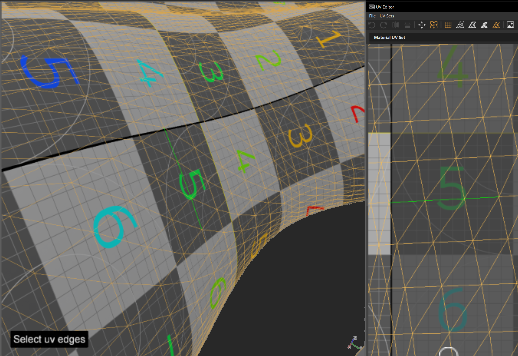UVs
The UV Editor is now available in VRED Professional and VRED Design.
For reference information on the UV Editor, see UV Editor.
Useful Things to Note
The UV Editor works with any triangle geometry, either triangle meshes or NURBS data (surfaces and shells) that has been tessellated in VRED.
If the geometry is re-tessellated, its UV coordinates can be preserved by checking Preserve UVs in the re-tessellation dialog. The UV layout will be transferred from the old to the new tessellated surfaces after tessellation is finished.
Note:When there are UV cuts within a surface, it is possible that these cuts cannot be properly reconstructed after re-tessellation. The algorithm will create a cut in the area of the original cut, but depending on how the triangulation has changed, it could look different. For example, the cut could appear as a jagged line, instead of as a straight one.
Edge constraints (see Constraint U / Constraint V) are not kept on re-tessellation.
Ensure your materials have a Mapping Type set to UV. To check, in the Material Editor, select the material, then in the Diffuse Texture section, check Mapping Type. If set to Planar or Triplanar, you will not see the result on the geometry.
UV islands, edges, and vertices can also be selected in the viewport in 3D rendering. We recommend enabling wireframe selection to display the current selection.
- To simplify the wireframe selection view in the viewport, ensure that this option in the preferences is disabled: Edit > Preferences > General Settings > Selection > Wireframe > Always in Front.
- To select only UVs on the front most surfaces within a rectangular selection in the 3D viewport, disable Edit > Selection > Use Depth Selection.
How to Display UVs in the UV Editor
In the Menu Bar, select Scene > UV Editor.
In the UV Editor, under Selection Mode, choose
 (Objects).
(Objects).In Objects mode, only nodes in the scene can be selected in the Scenegraph and nothing can be selected in the UV Editor view.
In the Scenegraph, select geometry nodes. The UVs for the selected nodes are displayed in the UV Editor.
Alternatively, select the nodes in the Scenegraph, then select Scene > UV Editor to open the UV Editor with the UVs for the selected nodes displayed.
How to Select Islands of Selected Geometry Nodes
To select all islands, in the UV view use Ctrl + A.
In the UV Editor, Shift+middle-click in the view, then choose Islands from the context menu to set the Selection Mode.
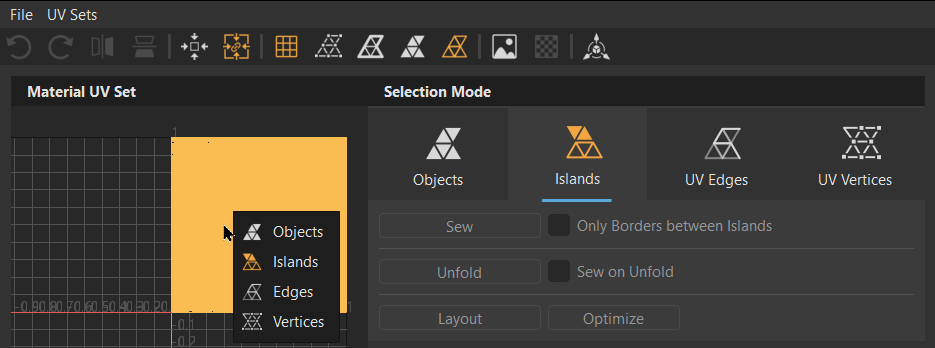 Tip:
Tip:Another way to do this is to click
 (the Islands icon).
(the Islands icon).(A UV island is a sub-part of the mesh where every vertex is directly or indirectly connected to every other vertex in the same island.)
Use the standard VRED object selection methods to select islands. See Selecting Objects in the Viewport.
Tip:When using rectangle selection in the viewport to select islands, you can select either islands on the front-most surfaces or any islands, including ones that are behind another surface. In the Menu Bar, toggle Edit > Selection > Use Depth Selection off to select only islands on the front-most surfaces.
If you want to work with UV islands on a shell node (
 ), select the shell node, not its individual surface components. When selecting the shell node, the UV Editor knows which surfaces of the shell are neighbored to enable sewing of islands on neighbored surfaces.Note:
), select the shell node, not its individual surface components. When selecting the shell node, the UV Editor knows which surfaces of the shell are neighbored to enable sewing of islands on neighbored surfaces.Note:Two surfaces are detected as neighbors, if their triangles are lining up perfectly where the surfaces meet.
You can also select individual surface nodes of a shell and work with these in the UV Editor; however, the UV Editor will treat those surface nodes independently and will not consider which surfaces are neighbored.
When you select an island, its corresponding sub-mesh is highlighted white in the UV Editor.
The UV islands are drawn in the Render Window, if
 (Wireframe) is enabled in the QuickActions Bar. This adds a wireframe overlay over the solid shading of the selected nodes. The colors are configurable in Edit > Preferences > General Settings > Selection. White is the default color for selected islands.
(Wireframe) is enabled in the QuickActions Bar. This adds a wireframe overlay over the solid shading of the selected nodes. The colors are configurable in Edit > Preferences > General Settings > Selection. White is the default color for selected islands.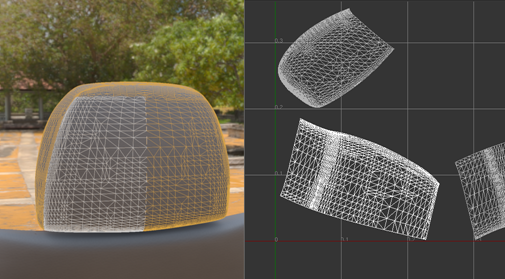
To see the borders, in the UV Editor, under Visualize, select Show Borders.
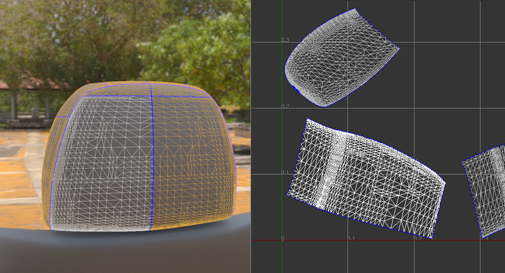
How to Select Islands That Should Be Sewn
To select all islands, in the UV view use Ctrl + A.
In this example, we manually select islands that should be sewn, and use Unfold, with Sew on Unfold checked.
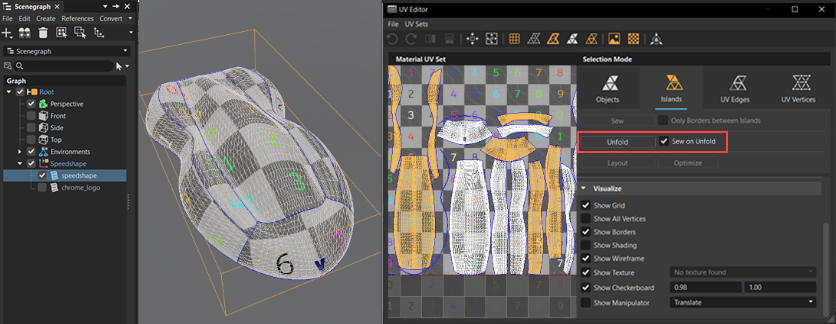
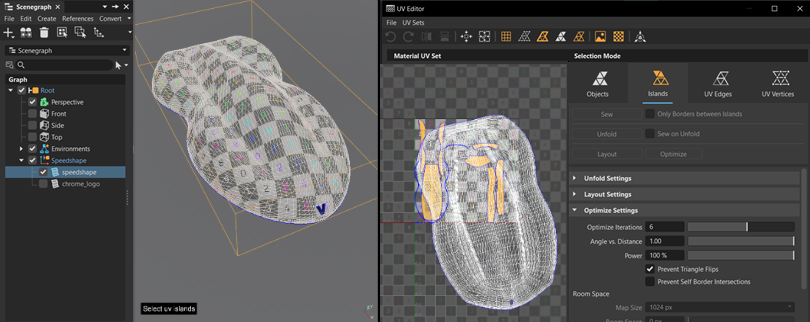
The selected islands were sewn into a single big island and this island was unfolded.
Further optimize the UVs (in this case to smooth out the small bump seen below) and layout the resulting island.
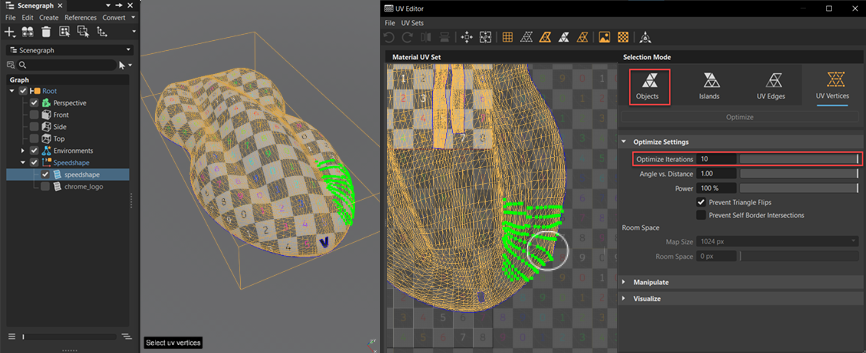
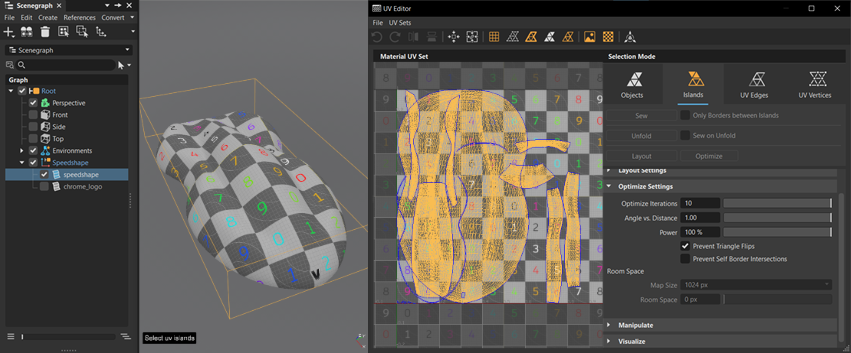
In some cases, especially when working with shells, you might get a better result with sewing the islands, then using Unfold & Layout from object selection again. Unfold uses the existing UVs as input, while Unfold & Layout in object mode ignores UVs (but respects the island structure), and uses the actual 3D shape as input. This can help to prevent issues like the small bump in the island border seen above.
You can also select islands in the 3D viewport and sew those without unfolding them first.
If working with a rather flat object that is not closed, try using Sew on Unfold in object mode. This sews together all islands (that can be sewn) before unfolding. Islands can only be sewn if they’re neighbors in 3D.
How to Select Edges of Selected Geometry Nodes
To select all edges, in the UV view use Ctrl + A.
In the UV Editor, Shift+middle-click the view and choose UV Edges as the Selection Mode.
Tip:Another way to activate edge selection is to select
 from Selection Mode.
from Selection Mode.Use the standard VRED object selection methods to select the edges. See Selecting Objects in the Viewport.
Tip:To select only those edges on the front-most surfaces, or alternatively to select all edges in the selection frame, whether they are behind another surface or not, in the Menu Bar, toggle Edit > Selection > Use Depth Selection either on or off.
In the UV Editor, holding the Shift or Shift+Ctrl keys and hovering the cursor over an unselected edge, highlights it the color set in the Selection Preferences. Same can be said for hovering over a selected edge. Selected edges are green by default, but can also be customized.
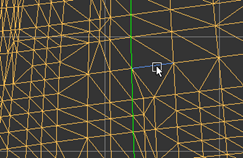
The UV edges are drawn in the Render Window, if
 (Wireframe) is enabled in the Toolbar.
(Wireframe) is enabled in the Toolbar.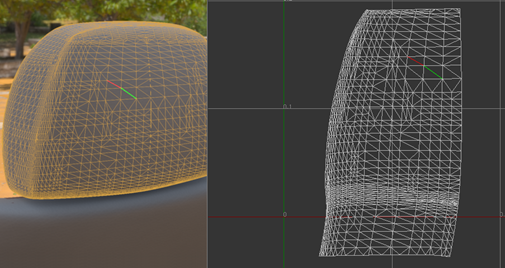
To Select a Chain of Edges
In the UV Editor, Shift+middle-click the view and choose UV Edges as the Selection Mode.
Define the edge selection path by picking at least two points.
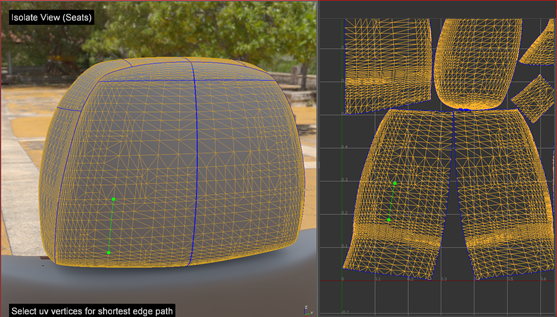
The shortest path connecting each way point, in the order it was picked, is selected and added to the current edge selection.
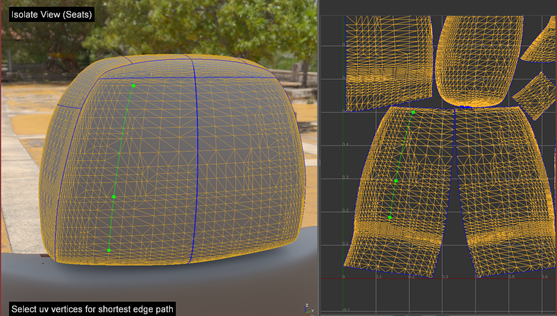
To exit Select Shortest Path mode, click the Select Shortest Path button again to toggle it off.
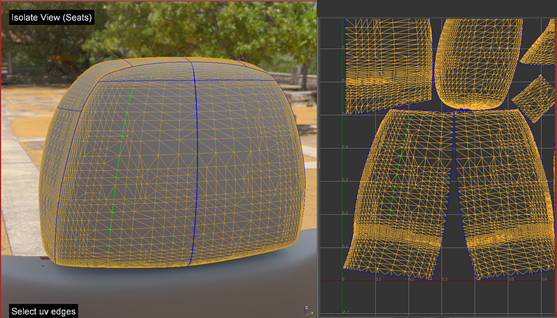
If any way point is located on a different UV island, a path that connects all way points cannot be constructed.
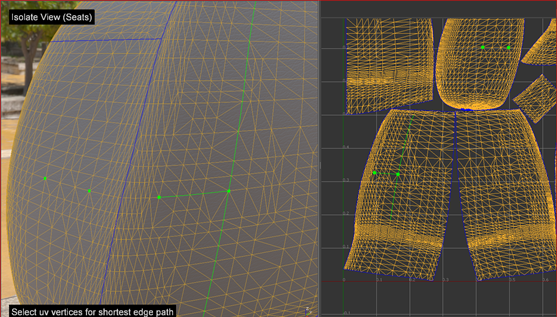
Adding a way point on the border between two islands may guide the path to go across the border.
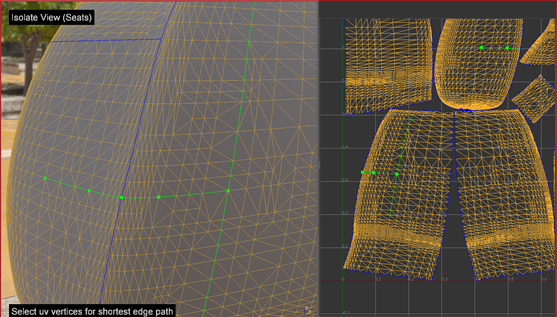 Tip:
Tip:Turn on Show Border when constructing a path.
How to Select Vertices of Selected Geometry Nodes
To select all vertices, in the UV view use Ctrl + A.
In the UV Editor, Shift+middle-click on the view and choose
 UV Vertices as the Selection Mode.Tip:
UV Vertices as the Selection Mode.Tip:Another way to activate vertices selection is to select
 from Selection Mode.
from Selection Mode.Use the standard VRED object selection methods to select the vertices. See Selecting Objects in the Viewport.
Tip:To select only those vertices on the front-most surfaces, or alternatively to select all vertices in the selection frame, whether they are behind another surface or not, in the Menu Bar, toggle Edit > Selection > Use Depth Selection either on or off.
In Selection Mode, check
 UV Vertices to display all vertices in magenta in the UV Editor.
UV Vertices to display all vertices in magenta in the UV Editor.The vertices are drawn in the Render Window, if
 (Wireframe) is enabled in the QuickActions Bar.
(Wireframe) is enabled in the QuickActions Bar.Hold the Shift or Shift+Ctrl keys and hover the cursor over a vertex to highlight it the color set in the Selection Preferences. Selected vertices are green by default, but can also be customized.
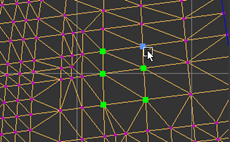
How to Cut and Sew Edges of a UV Mesh
Cut Edges
Cuts are important to the unfolding process. They allow the UV textures to unfold with as little distortion as possible. When unfolded, the UV mesh should lay flat without overlapping.
In the UV Editor, select
 (UV Edges) and select two or more edges.Tip:
(UV Edges) and select two or more edges.Tip:To highlight the borders, in the Visualize section, check Show Borders.
In the Automatic Seam Selection section, click Cut Edges.
The mesh is cut along the selected edges.
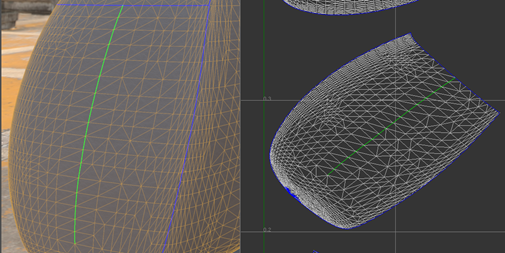
The edges become new borders after the cut.
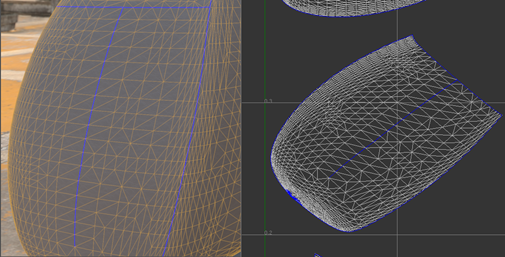 Note:
Note:Cutting border edges has no effect.
Sew Edges
There are two ways to sew edges: sew along borders or sew neighboring islands.
How to Sew Along Borders
In the UV Editor, select
 (UV Edges) and select two or more border edges to sew together.Tip:
(UV Edges) and select two or more border edges to sew together.Tip:Check Only Select Borders when selecting borders using rectangle selection.
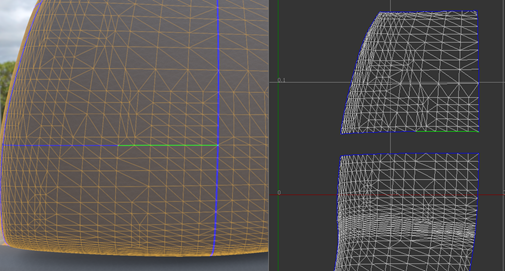
In the Automatic Seam Selection section, click Sew Edges.
If sewing is successful, a border edge becomes a normal edge.
The UV coordinates of vertices on both sides of a border are averaged and used as the new coordinates for the sewn vertices.
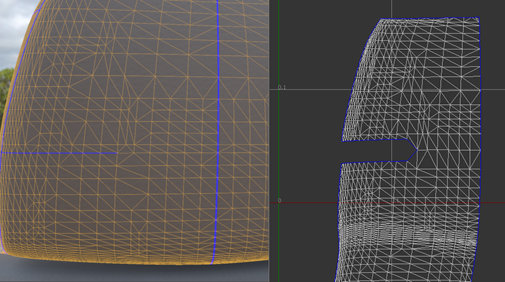
How to Sew Neighboring Islands
This method has the same effect as selecting corresponding border edges and sewing them using Sew Edges. However, this method may be more efficient, in some cases.
In the UV Editor, click
 (the Islands icon) and select one or more islands to sew together.
(the Islands icon) and select one or more islands to sew together.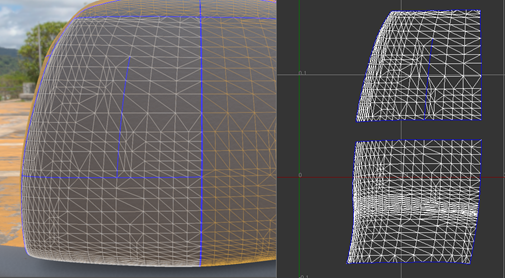
In the Automatic Seam Selection section, click Sew Islands.
VRED attempts to sew neighboring islands together.
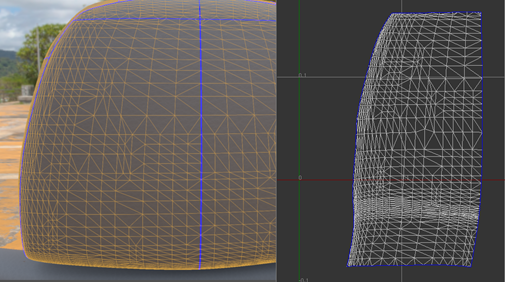
If the island has an internal border, which means the other side of the border belongs to the same island, it is also sewn. This may not be the desired behavior and can be changed by selecting the option Only Borders Between Islands, next to Sew Islands. When this option is selected, only borders between different islands can be sewn.
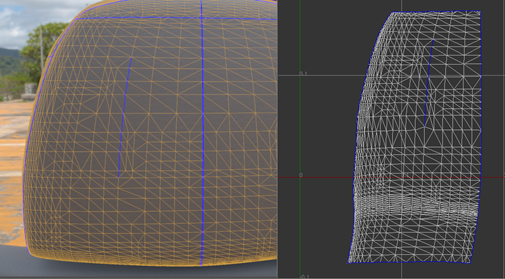
See the following:
- Sewing along non-border edges has no effect.
- To sew the border, the physical locations, normal vectors, and other per-vertex attributes of vertices on both sides of a border must be the same. For example, a physical gap cannot be sewn by the Sew tools.
- Only islands belonging to the same triangle mesh or shell can be sewn together.
Constrain Edges
How to make edges horizontally or vertically straight in UV space.
Use the Constrain to align island borders to the UV space axes.
Select the edges that you want to make straight.
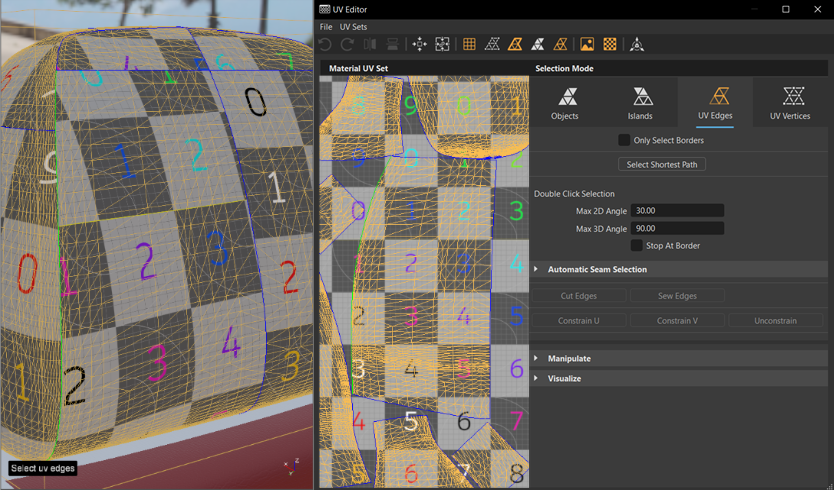
Selected edges along one border at the side of this island.
Click Constrain V to mark these edges as vertically constrained (i.e., constrained to become a straight line parallel to the V axis). To mark them as horizontally constrained, click Constrain U (i.e., constrained to become a straight line parallel to the U axis).
Marking the edges does not immediately change the UVs. The constraints only take effect when applying Optimize or Unfold to the UVs.
Constrained edges are highlighted with a different color. You only see this highlight, when the edges are no longer selected. Either go to island selection mode
 or Shift+right-click anywhere in the UV view to deselect all edges and check the set constraints. The colors for the constraint are configurable in Edit > Preferences > Selection. Default is magenta for horizontally constrained and cyan for vertically constrained.
or Shift+right-click anywhere in the UV view to deselect all edges and check the set constraints. The colors for the constraint are configurable in Edit > Preferences > Selection. Default is magenta for horizontally constrained and cyan for vertically constrained.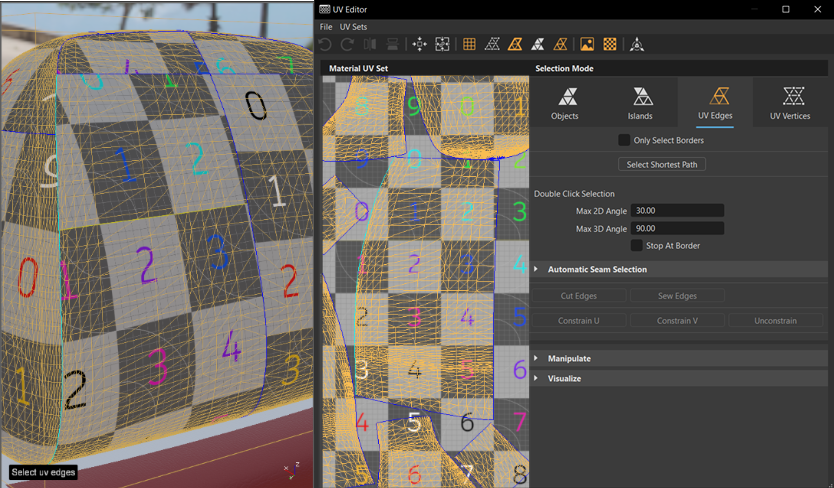
Vertically constrained edges are highlighted cyan.
To apply these constraints to the UV, go to Island selection mode (
 ).
).Select the island and click Optimize.
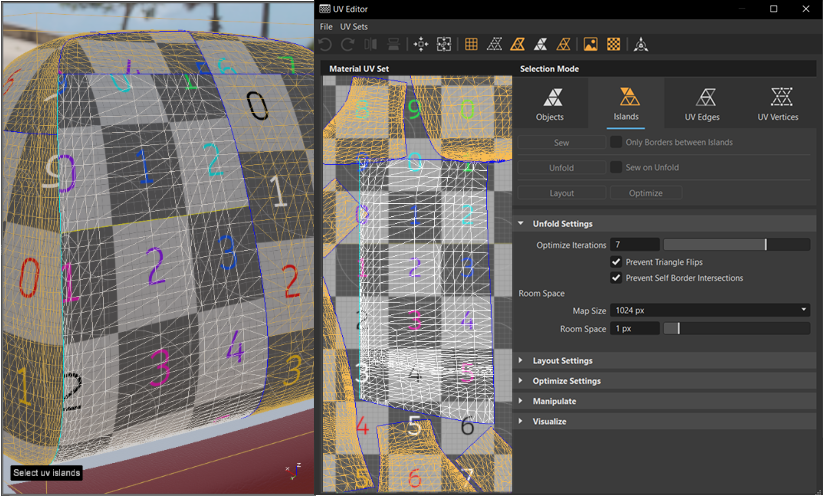
The constrained border edge is made vertically straight in UV space.
Set more constraints if needed, or remove any unneeded constraints, and click Optimize again.
Both Optimize and Unfold respect the constrained edges. If Optimize does not give a good result, try Unfold, instead.
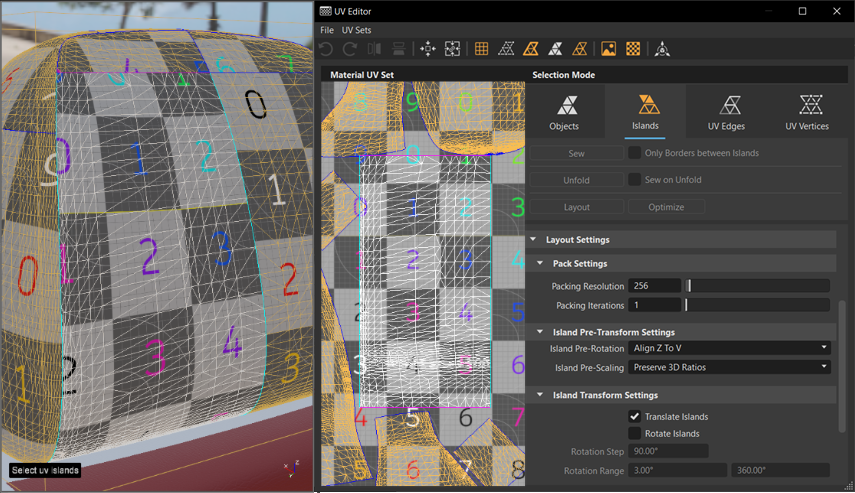
Added more edge constraints, both vertical and horizontal.
How to Unfold a UV Mesh
UV coordinates can be created by unfolding a surface in 3D space onto a 2D plane. Each UV island is an isolated and detachable piece, so it is the basic unit to perform unfolding.
The quality of unfolding depends on how easily each island can unwrap onto a plane. A relatively planar surface is usually easy to unfold and produces a good result. On the other hand, a surface wrapped with a lot of tension is tricky to unfold and usually incurs a lot of distortion. Experience and effort may be needed to cut and sew the surfaces before unfolding to achieve a satisfactory result.
How to Unfold All Geometries
Select the geometries to unfold.
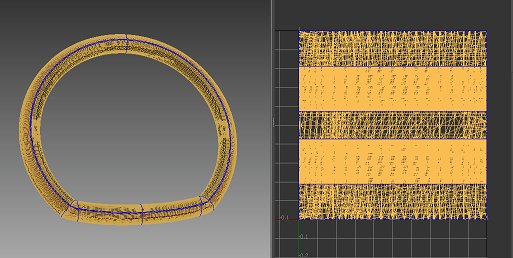
In the UV Editor, click Unfold & Layout.
VRED attempts to pack the UV islands (using Pack Settings) belonging to the same geometry into the unit UV space after unfolding.
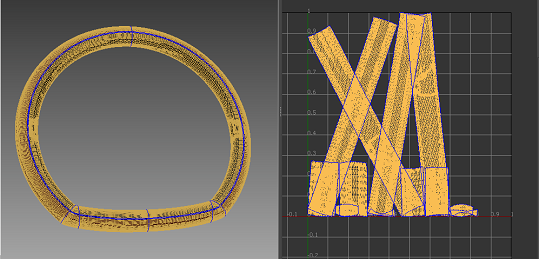
How to Unfold Selected Islands
In the UV Editor, choose
 (the Islands icon) and select one or more islands to unfold.
(the Islands icon) and select one or more islands to unfold.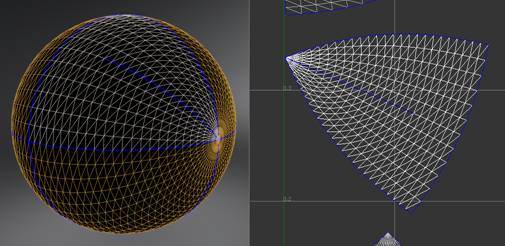
In the Selection Mode section, click Unfold.
The new UV coordinates for the selected islands are scaled roughly as large as before unfolding and placed in their original position.
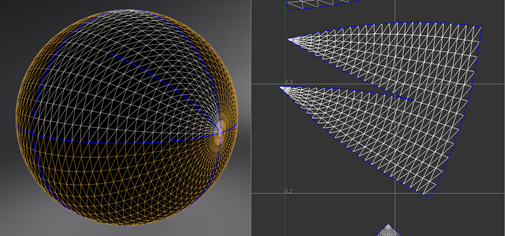
Using Texture Manipulators
When working with textures, to fix their projected placement, use the tools in the Projection section. The mode selected determines the manipulator that appears.
This example of a planar manipulator provides an explanation of what each component does:
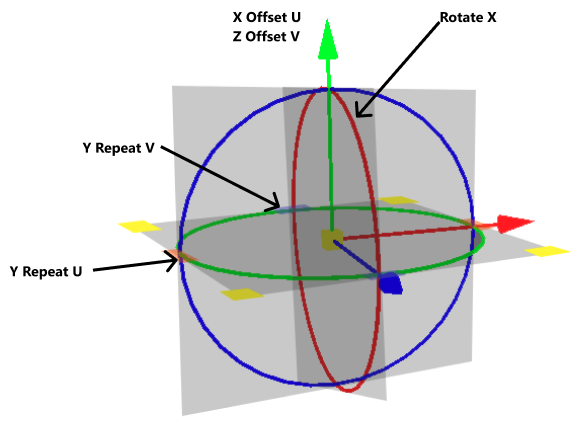
For additional information on texture projection and the different modes, see Projection.
- Click the Project button.
- Click Manipulate. A manipulator for that mode (Planar, Triplanar, or Cylindrical) appears in your scene.
- Use the various handles to move, rotate, and scale the texture to correct its placement.
How to Manipulate UVs
Use the options in the Manipulate section of the UV Editor to manipulate coordinates of selected islands/edges/vertices.
How to Flip UVs in U or V Direction
To flip the UV coordinates of selected islands/edges/vertices in either the U or V direction, under Manipulate, click Flip Vertical or Flip Horizontal.
How to Translate UVs
To translate the UV coordinates of selected islands/edges/vertices:
Hold the Shift + W keys to toggle the display of the Translation manipulator. The manipulator displays at the centroid position of the selection.
Continue to hold the Shift key and hover over the manipulator to select one or both translation axes and highlight the corresponding arrow in yellow.
Still holding the Shift key, drag to translate the selection.
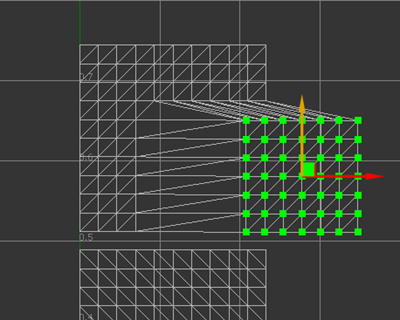
How to Rotate UVs
To rotate the UV coordinates of selected islands/edges/vertices:
Hold the Shift + E keys to toggle the display of the rotation manipulator. The manipulator displays at the rotation pivot position of the selection.
Continue to hold the Shift key and hover over the manipulator to select the rotation tool and highlight the manipulator in yellow.
Still holding the Shift key, drag to rotate the selection.
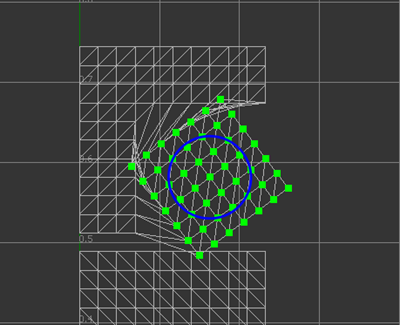
To move the position of the rotation pivot, hold the Shift+Q key to display a manipulator with two yellow arrows. Drag to reposition the pivot.
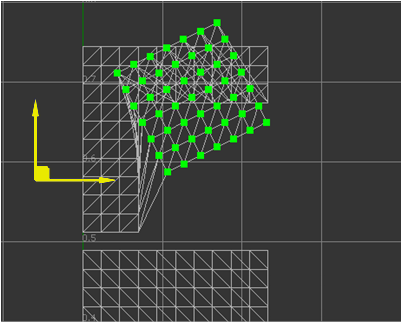
How to Scale UVs
To scale the UV coordinates of selected islands/edges/vertices:
Hold the Shift + R keys to toggle the display of the scaling manipulator. The manipulator displays at the scale pivot position of the selection.
Continue to hold the Shift key and hover over the manipulator to select a scaling axis and highlight it in yellow, if the cursor is near that axis, or select both axes, if the cursor is near the square at the top right.
Still holding the Shift key, drag to scale the selection.
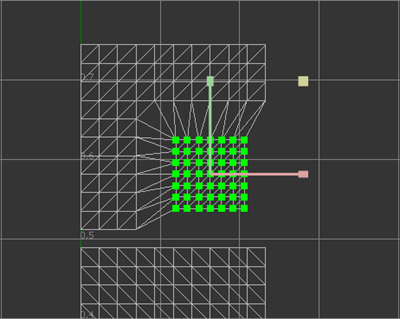
To move the position of the scale pivot, hold the Shift + Q key to display a manipulator with two purple arrows. Drag these arrows to reposition the pivot.
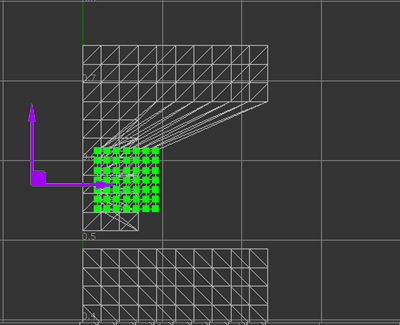
How to Modify Multiple UVs at Once Using Lattice Deformation
Modify the layout of multiple UVs at once, using a 2D lattice deformer.
How to Create a Lattice
Select the islands/edges/vertices you want to manipulate, and in the UV Editor, under Manipulate, select Use UV Lattice. A lattice that is large enough to cover all the selected vertices is created.
or
To start a new lattice, hold the Shift key and drag a rectangle in the UV Editor.
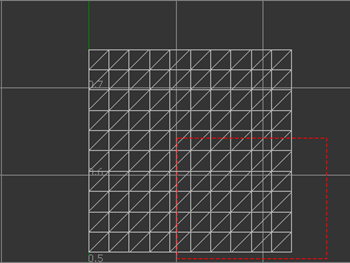
To toggle the automatic fitting of the rectangle you dragged to the bounding rectangle of the selected vertices, select Use Bounding Box.
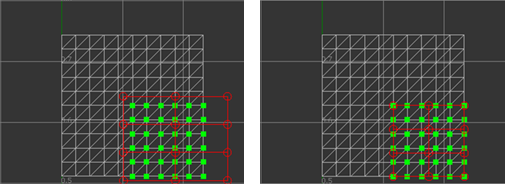
Left: Off, Right: On
Circles represent the control points of the lattice. They are distributed evenly in rows and columns. You can select control points and the lines connecting them. Select and deselect them the same way you select islands/edges/vertices.
Selected control points are yellow. If the two points that connect a line are both selected, then that line is also yellow.
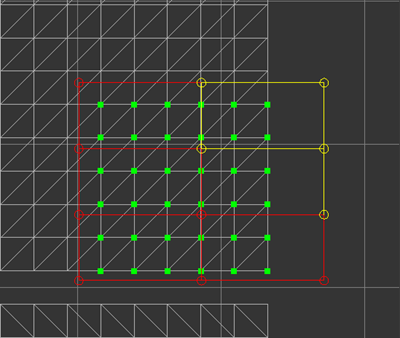
How to Deform UV Coordinates
Select lattice control points and drag.
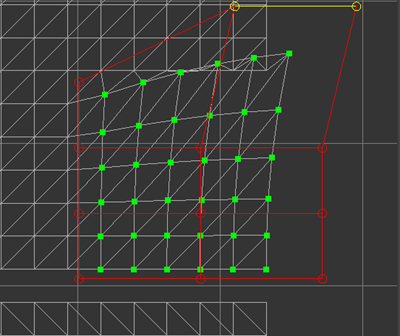
Columns and Rows specify how many control points each row and column of the lattice has. The more columns and rows there are, the more local the influence of moving a control point.
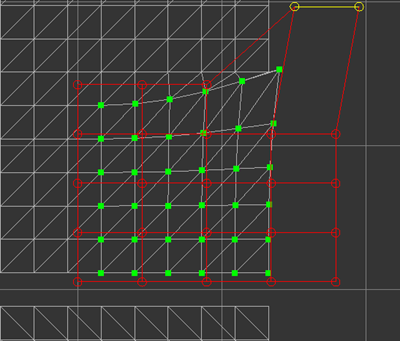
Falloff 1.0 - Falloff specifies how much influence the deformation should bring to the original UV coordinates. It is a value between 0.0 and 1.0. If 1.0 is used, UV coordinates are fully influenced by the deformation. If 0.0 is used, UV coordinates are not affected by the deformation at all. 1.0 was used in the previous example and 0.0 is used in the following example.
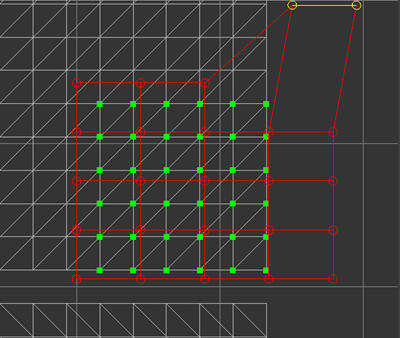
Falloff 0.0
Best Practices
If a complex surface geometry comes in as a normal triangle mesh, which is one large piece, UV islands need to be created, by cutting the surface, so each can be unfolded. If the unfolding result looks strange or unbalanced, more cuts are likely needed in the surface.
A shell node, which may contain a number of NURBS components, is considered as one geometry node and the UV coordinates of neighbor NURBS surfaces may be sewn together. If each NURBS surface is small and relatively planar, sewing UV islands of NURBS surfaces to form larger islands and then unfolding may be a more efficient way to work.
Sometimes the triangle mesh is completely split. This can be detected by enabling border visualization. Every edge will be drawn blue. If unfolding is done on such geometry, a result like this will be returned.
Do not use Unfold on a geometry with split triangles. Instead, first merge the geometry vertices by using Scene > Optimize > Unify Vertices. Or, in UV Editor in Island selection mode, select all islands using Ctrl + A and press Sew.
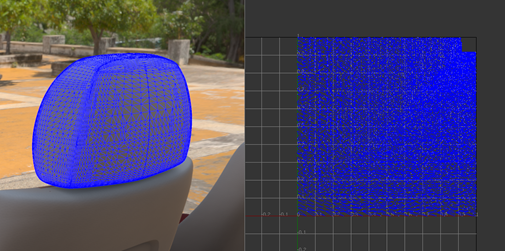
Importing and Exporting for a Second UV Channel via FBX
When importing a model into VRED, using FBX from Maya, Max, Blender, or other DCC (digital content creation) tools, the first channel is imported as a Material UV set. The second channel will now be imported as a Lightmap UV set.
When exporting a model from VRED to other DCC tools, both UV channels are kept and named as they were in VRED. This makes it possible to roundtrip between VRED and other DCC tools, using FBX, without losing the UV sets for the materials (first channel) or lightmaps (second channel).

The DCC can have more than two UV channels. VRED can only deal with the first and second. All others will be lost when exchanging data with DCC tools using FBX.
